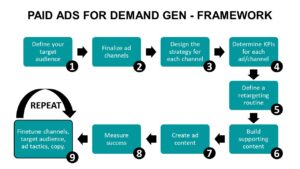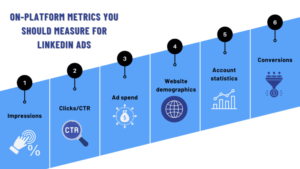Performance marketing
Elevate your brand and generate more leads with paid ads
Use precise targeting methods on Google ads and LinkedIn ads to generate demand and leads.












WHAT WE CAN DO FOR YOU
Ads that hit the nail on the head when it comes to targeting
Google ads
A combination of search, display, and video ads to make it easy for your target audience to find you.
LinkedIn ads
Firmographic and demographic targeting combined with a well-balanced strategy and execution to improve awareness and generate leads.
Competitor research
Comprehensive research and analysis of competitors’ Google and LinkedIn ad campaigns, creatives, and other tactics.
Run ads
that convert
Best-in-class ad copy, creatives, and targeting
to attract customers.
What makes us stand out from the crowd?
Industry-specific copy
We write ad copies that are relatable to your target audience.
Optimization on the go
We don’t create ads and disappear. We consistently optimize them for the best results.
Balanced approach
Simultaneous focus on short-term and long-term lead generation goals.
Marketing Insights
Whitepaper

B2B Marketing in the AI Era – How to Adapt
AI is changing the way we operate in every industry, and marketing is no different. In this whitepaper, learn the various applications of AI in marketing – from content generation to email marketing and text-to-speech conversion. Also learn how B2B marketers should adapt and what an AI-led future looks like in marketing.
Blog
This article was originally published in the Elevate Your Marketing newsletter and has been repurposed and republished here with the author’s permission. Here is the link to the original article.
Setting the context
Paid ads are a territory we have not explored in this newsletter yet. It is mostly because there is a ton of content out there on how to manage and optimize your ads for better results.
But today, we intend to share a different perspective on the topic with you. A view that at least some will see as unconventional, counterintuitive, and unusual – using paid advertisements to generate demand for your business.
Hence, this blog is going to be a little ‘adventurous’. So let’s get ready. We have a lot to cover.
Note: My article on how to create a demand gen engine is a good precursor and addition to this piece. So I would recommend you check it out. The link is given below:
A Step By Step Guide To Creating A Demand Gen Engine For B2B Businesses
Paid ads for generating demand? Really?
Yes, I mean it.
Traditionally, paid and PPC (Pay Per Click) ads have been used for capturing demand where marketers and growth professionals look for some quick wins. This usually involves capturing prospects who are in the market to buy your products and services. In the B2B world, Google ads (and to some extent Facebook ads) have thrived on this idea for a decade now.
For instance, think about someone who is looking for machine learning monitoring solutions. As one of the steps, the buyer might search on Google to find information about the leading providers of machine learning monitoring solutions. If there are companies bidding for relevant keywords related to the domain in Google ads, it is very likely that the first few results on SERP are sponsored ones.
In this case, the expectation of most marketers is that the buyer clicks on the ad and immediately converts into a lead.
While an immediate conversion could very much happen from an ad (depending on the intent of the user and the stage at which he/she is in the buying journey), a vast majority of interactions do not end up like this. They either act as a tool for creating awareness or as one of the many touchpoints in the buyer journey.
And this is the main reason why you need to look at paid ads as a demand generation channel as well, and not just a demand capture engine.
In addition to the above, given below are the other reasons I believe any paid ad platform can be used as a demand generation tool:
- Almost every user needs a ‘warm-up’ before he/she buys your solution (unless they are already familiar with your business and what it can offer). While techniques like content marketing, SEO, and video marketing are scalable ways of doing it, they take time. Using ads here to generate top-of-the-mind awareness is a way to overcome this challenge.
- Adding to the above point, taking a buyer through different stages of the funnel requires multiple layers of touchpoints (remember the multi-dimensional B2B marketing funnel?). This can be done in a very pointed manner with ads using retargeting. Retargeting allows you to target users based on their past actions across different time intervals (also called windows). Examples of such actions include website visits, video views, ad impressions, etc.
- Ads help you target the users you want rather than doing a spray and pray. As I mentioned before, content marketing is scalable. But it’s tough to target a very select persona using it (I mean you can do that to some extent using SEO, but the % of relevant visits you get is usually not that high. Also, it takes time). Whether it’s Google ads, LinkedIn ads, or Facebook ads. you can use different parameters such as keywords, firmographic criteria, demographic characteristics, interest groups, etc., to do pointed targeting.
We will talk more about the methodology and framework to do demand gen using ads – the right way – in the next section. But here, I wanted to lay the foundation by proving that paid ads can definitely be used for B2B demand generation.
A framework for using paid ads for demand gen
Before we even look at the framework, we all need to understand that using ads for generating demand for your business requires a shift in mindset first. If you look at ads purely as a method to quickly generate some leads, you got some work to do in terms of your approach towards paid marketing and demand gen.
The whole premise of this new perspective is that it’s worth spending money on ads to generate demand which can later be leveraged to create a solid pipeline for your business.
With that in mind, here is the framework you can use to design your paid ads campaigns in a way that supports your demand gen goals:

At the outset, the framework might look simple. But let us get to the specifics of it to make it more relevant and relatable from a practical standpoint.
1. Define your target audience
This is fairly simple. Here, I am referring to creating a general criteria for your target audience. You can do this along the following parameters:
- Firmographic criteria such as region, revenue, industry, number of employees, funding details, etc.
- Demographic characteristics such as job title, function, interests, recent job switches, age, gender, etc.
2. Finalize ad channels
This might be a little deeper than you think. It’s not about picking 1 or 2 channels from popular ad platforms such as Google, Facebook, or LinkedIn. You need to go one level further and look for additional channels you can advertise on.
Ask yourself the following questions to find those channels:
- Does my TG (Target Group) listen to podcasts?
- What are the media companies and magazines (both online and offline) that have an active audience in my niche?
- What about their favorite YouTube channels?
You can use a tool like SparkToro to find this information.
The next question is – what do you do with this information?
Unlike using the ad interface of Google, LinkedIn, YouTube, etc., tapping into the above channels requires a different approach. For instance, if you need a YouTube creator to endorse your product or service, you need to get in touch with him or her individually. The same is the case with podcast advertisements. To complement your results from SparkToro, you can also try using a tool like Upfluence to find influencers in your space.
The idea here is not to ignore popular ad platforms, but rather add newer ways of reaching your target audience through innovative ways of advertising.
3. Design the strategy for each channel
This is where the channel-wise optimization tactics and techniques come in. For example, Google search ads involve defining the following:
- Campaign type
- Keywords
- Budget
- Headlines
- Descriptions
- Callouts
- Sitelinks
- Landing page
- Structured snippets
- UTM tracking
There is more to Google ads than the above. But you get the point here. Depending on the platform you are using, you optimize various elements such as targeting, messaging & copy, tracking methodology, etc., to make sure you get the best out of your advertising efforts.
The only thing to keep in mind here is that your objective is to generate demand, and not leads. You are aiming to create a top-of-the-funnel demand layer for your business. Hence, your tactics for each ad platform have to be designed accordingly.
For instance, in Google search ads, you need to stay away from using transactional keywords (more about types of keywords here). Similarly, for every platform or ad type, make sure your copy and creative are not focused on immediate conversion (unless it’s a retargeting ad).
4. Determine the KPIs for each ad or channel
The KPIs (Key Performance Indicators) for your ads and channels should help you to measure how much demand you have been able to generate. However, this doesn’t mean that you measure the top-of-the-funnel metrics alone. You also need to figure out how this demand resulted in bottom-of-the-funnel outcomes.
Let us take the example of LinkedIn ads here. The different types of on-platform metrics you would measure are:

- Impressions
- Clicks/CTR
- Ad spend
- Website demographics
- Account statistics
- Conversions
In a similar fashion, define the metrics you would like to measure for each channel or ad type. You also need to extend the measurement beyond the native platform to whatever attribution tool you are using (say Google Analytics) to ensure your demand gen goals are met (we will discuss measuring success again in one of the upcoming steps in the framework).
Also read:
10 metrics to measure B2B brand awareness and reach
Metrics you should measure to assess the effectiveness of your B2B marketing efforts
5. Define a retargeting routine
Retargeting is nothing but the exercise of targeting a segment of people who have already taken an action on your ad or content. It could be an impression, click, or even a video view.
Let us look at how this works for LinkedIn.
At a 10000 feet level, you need to essentially decide 4 things when it comes to running a retargeting ad:
- The retargeting criteria/segment of the audience you wish to retarget.
- The ad type you choose to do the retargeting.
- The asset you promote (case study, customer story, your USPs, etc.).
- The period for which you will run the retargeting campaign.
The objective of this step is to define the retargeting layer in a way that continues to generate demand for your solutions, or directly convert the demand you generated in the cold or top-of-the-funnel ad layer.
6. Build supporting content
This is nothing but creating the asset you are planning to use for the ad. Examples include:
- Landing page
- Video
- Carousel
- Banner
- Whitepaper
- Case study
- Ebook
Again, remember that your primary objective is to attract some eyeballs to your business, and not force them or trick them into buying. Think about giving value first before you ask for it.
7. Create ad content
This is quite straightforward. The ad content you need to create will completely depend on the ad platform, your target audience, and the ad type. But broadly speaking, there are two things you need to work on here:
- The text content: the ad copy (headlines, descriptions)
- The creative: banners, carousels. videos, etc.
When it comes to ad content, here are some best practices to make sure that you stay focused on demand generation:
- Assume your user doesn’t know your business. This will help you approach the content from a point of view of introducing what you offer than trying to sell what you have.
- Avoid using transactional and forceful copy.
- Always give something of value to the user in the form of expert tips, playbooks, best practices, etc., before you ask for something in return.
8. Measure success
This relates back to step #4 – the KPIs you defined for each ad channel. You need to have the right measurement systems in place to evaluate the success of your paid ads from a demand gen standpoint. This requires a two-pronged approach:
- Measure metrics at a campaign or platform level.
- Measure relevant metrics such as pipeline, revenue, increase in brand awareness, etc., at the organizational level.
The former is about measuring on-platform metrics while the latter is about understanding how the demand has led to real business outcomes.
9. Finetuning
Irrespective of your objective of running ads, you need to keep fine-tuning target criteria. ad copy, supporting content, budget, choice of channels, etc. Advertising is an exercise that requires continuous experimentation and optimization. So be sure to make the necessary changes as you progress.
The act of trial and error shouldn’t stop with one cycle. You need to keep doing it as long as the ad engine is running. That’s what great marketers do, isn’t it?
Conclusion
I know that we covered a lot in this blog – a framework for using paid ads for demand gen, different ad optimization techniques, targeting criteria, metrics, and much more. Rather than getting into the very details of managing and optimizing ads on various platforms, my objective was to set a process for leveraging paid ads to attract people who are currently not ready (or warmed up enough) to buy your solutions. I also wanted to discuss a whole new perspective on using paid ads in our marketing efforts.
In addition, my point here is not that you ignore conversion-based ads completely. What you need to do instead is to find a balance between the two approaches.
Hope this blog served these purposes and was a useful read for you all.
Skalegrow – B2B email marketing services
With marketing getting tougher and tougher, every wrong foot you make might hamper your growth. What you need is the right guidance and a helping hand. This is where Skalegrow can make a sea of difference.
Skalegrow helps IT, tech, SaaS, and embedded systems companies leverage new-age marketing tactics to grow their business. Check out the below intro video to learn more about what Skalegrow brings to the table:
Video
Content gap analysis or keyword gap analysis is the process of finding keywords your competitors are ranking for but your website is not. This is one of the best methods to discover new keywords to create SEO-optimized content around.
This video covers the step-by-step process of doing content gap analysis using Ahrefs, one of the most popular SEO tools in the market. You will see how to do it on the tool in addition to learning how to choose the right keywords for creating content.
Template
Do you want to organize your content marketing activities better? Download this ready-to-use B2B content calendar template and plan your content activities well in advance. It covers everything you need for managing different content items like blogs, case studies, ebooks, and more.
Checklist
Video marketing in B2B can be often overwhelming. There are plenty of steps involved including planning, writing the script, shooting the video, etc. It can be at times difficult to ensure you have covered all the basic steps.
Introducing the complete video marketing checklist. It covers all the necessary elements related to video marketing – from planning to creation and optimization to promotion. Use this as a guide while planning your video marketing activities.
E Book
Unconventional lead generation techniques
Lead generation is challenging. With almost all B2B businesses using the same methods, standing out and grabbing attention has become all the more difficult. That’s why we have created this ebook. It explores 9 unconventional B2B lead generation techniques that will help you become the purple cow in the sea of sameness.
These techniques are aimed at helping you develop a new perspective and inspire you to try something new and exciting when it comes to generating demand and leads for your business.
Webinar
Marketing Professional Services – How To Stand Out
The professional services industry is built on trust and confidence. Hence, the marketing strategy of these businesses should also reflect the same. In this webinar, listen to Naseef KPO and Rati Acharya as they discuss how to do marketing right for professional services companies. From choosing the right channel to standing out, learn all the tips and tricks you need to know. Tune in at 7:30 PM IST on Dec 18th, 2024.




